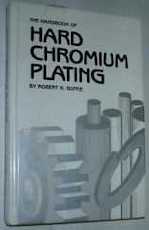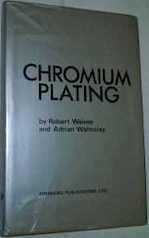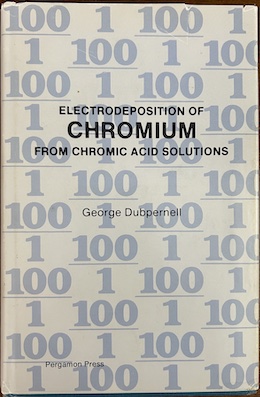
-----
Removing chloride from Chrome plating solution
Chrome plating solutions can become contaminated with chloride by carryover from an acid dip or nickel plating tank, chlorides in the makeup water, or an accidental addition of a wrong chemical. Prevention is easier than the cure, so DI water should be used for makeup and a DI rinse before plating may be appropriate.
The possible cures discussed here include dilution, dummying, and precipitation with silver compounds.
Q. Dear sir we want to check the chloride test for hard chrome plating, so anyone give me the procedure for testing of chloride.
Gaurav sharmaSenior executive - Noida
July 11, 2024
A. Hi Gaurav.
We appended your inquiry to a thread where Jon Barrows has answered that question. Also Tom Pullizzi answers it on thread 1232. Ion chromatography is possible as mentioned by Terry Tomt, but prohibitively expensive for a lot of shops. Please follow up if it's unclear or you have other questions about it.
Luck & Regards,

Ted Mooney, P.E. RET
Striving to live Aloha
finishing.com - Pine Beach, New Jersey
Ted is available for instant help
or longer-term assistance.
⇩ Related postings, oldest first ⇩
Q. Looking for the best way to remove chloride contamination from my chrome tanks. I'v been in touch with our chemical supply company and also talked to a competitor about a good solution to this problem, what I heard from both of these sources was in complete contradiction to each others methods. Please advise.
Thank you,
1997
by Robert K. Guffie

on eBay (rarely) or Amazon (pricey)
or AbeBooks (rarely)
(affil link)
A. The best method that I have found is to do a draw off the bath.
Some people add silver oxide, but this should be done in a separate tank to ensure that the precipitated silver chloride is completely filtered out during the transfer back to the plating tank.
I have heard of people dummy plating the chloride out of the tank, but in an aqueous environment the chloride reacts with the water to form hypochlorous acid. I have not actually tried dummy plating to remove chloride, though.
One could probably remove the chloride with ion exchange resins, but that would probably remove the catalyst also.
A. Dummying is a good solution to chloride contamination. I do not remember the exact conditions, but I think it is done with a small cathode and high current density. I know it works. For more accurate conditions, leave a message for Jim Watts, he knows the answer for sure.
There is another possibility, to add barium carbonate. The chloride acts as a catalyst just like sulphate (actually a stronger one then sulphate) so by reducing the sulphate, you actually reduce the effect of the chloride. The chloride will decrease with time and then you will have to increase the sulphate again. It works!

Sara Michaeli
Tel-Aviv-Yafo, Israel
by Weiner & Walmsley

on eBay (rarely)
or Amazon (rarely)
or AbeBooks (rarely)
(affil link)
A. To remove chloride from a chromium plating solution, you can add silver oxide or silver carbonate. Both methods are expensive due to the cost of silver salts. Use stoichiometric amounts
Electrolytic dummying of the solution is very effective, especially if the contamination is high. There are a variety of recommended electrolytic procedures and one that I am familiar with (and it works) is to Electrolyze the solution using an anode to cathode ratio of 10:1 while maintaining an anode current density of 25 ASF.
Trust this helps.

Ken Lemke
Burlington, Ontario, Canada
Q. DEAR SIR
We have started a new nickel chrome facility.
to start with I added required sulfuric acid to make the required ratio of 200:1 but I found in the lab that it is nearly 340:1 and showing just half the sulphate addition. I could not understand where I am loosing my sulphate. My supplier has given the explanation that I have lost it as lead sulphate at lead anodes ( they are not new) and some of the sulphate has settled down on the walls of the tank which is a brand new PVC lining.
I don't agree with explanation as I have started several new chrome bath in hard chrome with new lining etc. but never observed such a amazing results.
One more thing here; initially I started with gradual addition of sulphate and the results were matching with theoretical values but after 2-3 days of trials the sulphate reduced drastically but the parts are coming fine still may be because of 65 ppm chloride content in my chrome bath.
Here I would like to point out that this particular bath had 200 ppm of chloride in the beginning which I removed by HCD at anode and subsequent addition of 5 lbs of silver oxide.
please suggest me where I lost my sulphate and for how long this trend would be continued.
yours

Hemant Kumar
- Florida, USA
1998
A. Interesting problem! It sounds like your chromium solution may not have been a brand new make up. This supposition is based on the fact that you had high chloride contamination.
If your solution came from another plating facility, knowing its history would be very helpful.
For example, if it had been an SRHS chromium (self regulating, high speed), the solution could be over suppressed. SRHS chromium solutions contained ingredients that helped control the sulphate and secondary catalyst if they started to get too high. These special ingredients would actually cause the sulphate to precipitate if it got out of range. If the sulphate got too low, it would allow the sulphate to come back into solution -- thus the "SR" part of the name.
If however excessive amounts of these special ingredients got into the solution, the sulphate content of the solution would be suppressed to a level below where acceptable work could be plated. To correct the condition, we would have to keep adding sulphate until we had consumed the excess special goodie.
This is one of a few scenarios that could be causing your problem. The important point is that if your solution came from another shop, you should investigate it's history, as it may point to the answer.
If its a new make up, that presents a more interesting problem.
Regards

Ken Lemke
Burlington, Ontario, Canada
Allowable Chloride and Sulphate Levels
Q. Dear Readers,
We would like to know the impact due to the high levels of Chlorides and sulphates in the Chrome bath and Nickel bath onto the plated components. Also, we would like to know the allowable limits of the chlorides and Sulphates in the bath.
We have commissioned a Ni-Cr recovery plant recently. In which the recovered Chrome and Nickel solutions contains chlorides and sulphates. Does this have some effect onto the plated components.
GOPALAKRISHNAN.NTVS-Suzuki Ltd. - HOSUR, TAMILNADU, India
2001
Multiple threads merged: please forgive chronology errors and repetition 🙂
Silver Carbonate for Reduction of Chlorides in HEEF-25?
Q. I'M LOOKING FOR INFO ON SILVER CARBONATE TO REDUCE CHLORIDE LEVELS IN MY HEEF 25 CHROME PLATING BATHS. IS IT SAFE? IS IT EASY TO WORK WITH? WILL THIS REALLY WORK? ANY INPUT WOULD BE HELPFUL.
Dean Tufano- Rochelle, Illinois, USA
2002
A. Hi Dean. Since HEEF-25 is a proprietary product from Atotech, and nobody else admits to knowing exactly what is in it, I think that as the starting point should be to tell us what the supplier suggests. Thanks and good luck.

Ted Mooney, P.E.
Striving to live Aloha
finishing.com - Pine Beach, New Jersey
Ted is available for instant help
or longer-term assistance.
2002
A. It is Silver Oxide, not silver carbonate to reduce or eliminate chlorides. The upper limit is 50 ppm chlorides in a bath when it may begin to interfere with the sulphate/chrome ratio. 150 GRAMS silver oxide added to 1,000 gals. chrome bath reduces chloride 20-30 ppm. Hope you are sitting down when you obtain the price for silver oxide. No it should not interfere with the HEEF process.
William F. Hemp- Grand Rapids, Michigan
2002
A. Hi Dean, to clean your electrolyte from chlorides, it is much cheaper and easier to work it out by dummy-plating. Putting silver-ions into the electrolyte precipitates AgCl AND AgCrO4. You get a lot of sludge and it is a very expensive treatment.
Best regards,
Switzerland
2002
Q. Dear Mr. Michael Hekli,
Can you be more clear about dummy plating. It sounds interesting to me.
Thanks in advance.
- India
2002
A. Dear Mr. VIKRAM,
For this kind of dummy plating you take a steel sheet or some steel rods and plate them with high current densities at your normal plating temperature for some hours. Then you work the chlorides out. It is not fast, but it works. You should control your effort by some chloride analysis.
Best regards,
Switzerland
A. I agree with Michael, dummy plating is the right treatment for chloride contamination.The treatment with silver is very expensive. As for the silver reaction, well it is true that you get Ag2CR2O7 at the beginning but after a while all the chlorides will precipitate and give AgCl before any silver ion precipitates the chromates. Just as with Barium carbonate addition, at the beginning Ba2Cr2O7 is formed as there are a lot of chromate ion and much less sulphate but it will shift towards the sulphate and create BaSO4.

Sara Michaeli
Tel-Aviv-Yafo, Israel
A. Hi,
I'm agreed with both Sara and Michael how to remove chloride. The cathode area must be lower than anode area. Also check the temperature because this will be very high if you not have a automatic cooling system.
Regards,

Anders Sundman
4th Generation Surface Engineering
Consultant - Arvika,
Sweden
Q. I AGREE DUMMY PLATING WILL REMOVE CHLORIDE IN HEEF 25 BATH. BUT HOW MUCH CHLORIDE AND HOW MUCH TIME REQUIRED TO REMOVE AT WHAT CURRENT?
SELVARAJ V- Coimbatore, TN, India
2003
A. Dear Selvaraj,
Removal of chloride requires a very high over voltage. Easy way to achieve this is swap the anode/cathode connections and place a former round Pb/Sn at the former cathode point. About 4 A/Sq in will exponentially reduce the chloride by about 20 ppm in 1st 2 hours.
Good Luck,
Ken
- Dublin, Ireland
August 7, 2009
Multiple threads merged: please forgive chronology errors and repetition 🙂
Why use silver nitrate in chrome plating
Q. We have recently lost our chemist and have determined that he was using an amount of silver nitrate in our chrome plating baths. We primarily plate cast irons and steels. No one is sure why silver nitrate is added or what it's effect is on the coating process. Any ideas?
Mark ElloffLaboratory Control - Baltimore, Maryland
2006
A. Silver salts are sometimes used to overcome chloride contamination but best not silver nitrate as the nitrate can cause the chromium deposit to turn dark.

Sara Michaeli
Tel-Aviv-Yafo, Israel
High current density dummying to remove chloride from chrome plating bath
Q. Hello,
I'm an employee of a small plating company.
Can somebody help me on how to remove chloride from my chrome plating tank? My chrome has a little rainbow stain problem; after I check it in the lab, the composition of Chromic acid:Sulfuric acid ratio (134 : 0.9 gr/ltr), and chloride was too high.
What problems are caused by chloride too high? How to remove it?
Thanks a lot everybody.

Agus Dedi Setiadi
gift for my home industry - Bandung, Jawa Barat, Indonesia
2006
A. Chloride contamination will lead to hazy, milky, or even no deposit. You can add in silver carbonate to precipitate out chloride as silver chloride while carbonate will turn into carbon dioxide and water.

David Shiu
- Singapore
A. I think dummying at 1,000 ASF will remove chloride as chlorine gas at approximately 160 °F. Try it with good ventilation; the gas is very nasty. You can also precipitate it out with silver oxide. High chloride can cause dull or hazy deposits in high current density areas among other things.
Good Luck

Trent Kaufman
electroplater - Galva, Illinois
A. Use small cathode surface area (4:1 anode to cathode ratio works well) heat solution to 150 °F dummy between 300-800 ASF; use light air agitation to help circulate solution. 4-6 hours will usually reduce chlorides by 10-20 ppm.
J. OttPlating Shop - Harrisburg, Pennsylvania
Analysis for chloride in chrome bath
Q. Hi all,
I'm working in a lab, just started analysis on chrome plating solution. I've tried to determine the chloride content in Chrome plate. The silver ring on the electrode was dissolved after a few titrations, and recovery of standard check is no good.
Is there any method other than titration available for the determination of Chloride in Chrome plating solution?
chemist - Singapore
November 9, 2010
A. ion chromatography
Terry Tomt- Auburn, Washington
A. If you are just checking to make sure that you don't have too much chloride as a contaminant in your chrome solution, I think the easiest method is a titration; but you don't need an electrode- just a good eye and some good clean glassware. I'm feeling generous, so I'll just give you a method that I have used for years.
Pipette
[pipettes on
eBay or
Amazon [affil link]
10 mL bath sample and 40 mL of 25% nitric acid into two 125 mL Erlhenmeyer flasks
⇦[125 mL flasks on
eBay or
Amazon [affil link]
. Set one aside as a turbidity reference. To the other add a few drops of 0.1N silver nitrate. Carefully titrate this solution (in fine, precise increments) with standard 0.010 N mercuric nitrate from turbid to clear. Add a few more drops of silver nitrate, if the turbidity returns, continue the titration back to clear. Repeat that step until the solution no longer turns turbid. Chloride ppm = 35.6 x mL of 0.10 N mercuric nitrate.

Jon Barrows, MSF, EHSSC
Kansas City
A. Use RO or DI for make up and for water additions and you will eliminate the chloride problem as trace amounts of chlorine gas at the anodes.
This assumes that you are not using HCl to activate the metal.
- Navarre, Florida
Q. Hi.Thank you for your tips. Really a great help to me. In the dummy method for removing chloride, is a metal rod or sheet metal better to use?
elham bolouri- mashhad.iran
September 3, 2014
by George Dubpernell"

on eBay or Amazon
or AbeBooks
(affil link)
A. Hi Elham. I think a small sheet would be good. Its surface area should be 1/4 of the surface area of your anodes according to J. Ott's posting. Dubpernell's "Electrodeposition of Chromium from Chromic Acid Solutions" ⇨
notes that the lead dioxide on the anodes is what converts the chloride to chlorine gas ... so perhaps the shape of the cathode isn't critical? Dubpernell also implies that you can't get all of the chloride with dummying, and may still want to precipitate the final small amount with a silver salt.
Regards,

Ted Mooney, P.E.
Striving to live Aloha
finishing.com - Pine Beach, New Jersey
Ted is available for instant help
or longer-term assistance.
Q. Hi Ted. I have a low surface area of the cathode was used to eliminate chlorine and chrome plating conditions were better. With silver nitrate salts, is other than the chloride precipitated?
elham bolouri [returning]- mashhad.iran
September 14, 2014
A. Hi again, Elham. I've never operated a chrome plating line -- all I know is what I read in the papers :-)
Sara Michaeli says other salts are preferable to silver nitrate; David Shiu suggests silver carbonate; Trent Kaufman suggests silver oxide. And, yes, Michael Hekli says silver chromate is also precipitated. Good luck.
Regards,

Ted Mooney, P.E.
Striving to live Aloha
finishing.com - Pine Beach, New Jersey
Ted is available for instant help
or longer-term assistance.
September 2014
![]() Hi ted. Thanks for guidance.
Hi ted. Thanks for guidance.
- mashhad.iran
September 15, 2014
Q. Dear all,
Can someone guide me how to remove chloride from hard chrome plating electrolyte. I found a few suggested that dummy plating also removes chloride. But there is a difference of opinion. If it is possible, what is the exact procedure?
If not, will a porous pot work well to remove chloride.
Hard chrome plating - Bellary, Karnataka, India
April 25, 2015
![]() Hi THYAGARAJ. We appended your inquiry to a thread which covers the subject exhaustively over a period of more than 17 years. I'm sure it will answer your general questions -- but get back to us with any remaining thoughts. Good luck.
Hi THYAGARAJ. We appended your inquiry to a thread which covers the subject exhaustively over a period of more than 17 years. I'm sure it will answer your general questions -- but get back to us with any remaining thoughts. Good luck.
Regards,

Ted Mooney, P.E. RET
Striving to live Aloha
finishing.com - Pine Beach, New Jersey
Ted is available for instant help
or longer-term assistance.
April 2015
A. In my opinion, heat up the solution to around 100 °C for an hour and well agitate; will decrease chlorides as chlorine gas with dummy plating sheet.

Aftab Jahangir
chemist - Karachi, Pakistan
May 15, 2015
Chloride stain mark on chrome surface
Q. Hello, we are carrying out chrome plating on plastic material. We have observed dotted stain mark on chrome surface after part storage for one month. After analysis in a lab for the stain mark element it was detected presence of Cl, i.e., Chloride. what are possible causes for the presence of chloride on chrome plated surface?
Dinu BhokareSr.Quality Assurance Manager - Pune, India
January 31, 2017
A. I'd suggest it would have to come from the final rinse waters.
Make final rinse in DI water.

Geoffrey Whitelaw
- Port Melbourne, Australia
A. Hi Dinu,
chloride stain on chrome plated surface, hydrochloric acid or chloride related chemical drain into your chrome tank, from the broken rack, or some other reason
1) remove chloride from chrome, dummy bath or decant solution then readjust chemistry
2) silver nitrate take your chloride out and filter out, this method is expensive.

Popatbhai B. Patel
electroplating consultant - Roseville, Michigan
A. Hi,
I think it comes from how you store the part.
Best regards

Anders Sundman
4th Generation Surface Engineering
Consultant - Arvika,
Sweden
Adding Chemicals in HEEF-25 Hard Chrome Plating
Q. I Just joined to this field, as I don't have any previous experience in chrome plating
it is so difficult to understand what's going on here also no one here is to support me as well.
My question here , I have got lab report for Chrome plating tank chemical analysis
Tank 1 - Capacity 3000 Litre
Chromic Acid- 183
Chlorides - 0.2 g/l
Density- 1.079 g/ml
sulphates 37 g/l
Copper 7.9g/l
Iron 1.8 g/l
Tank 2 - Capacity 3000 Liter
Chromic Acid- 273 g/l
Chlorides - 0.1 g/l
Density- 1.094 g/ml
sulphates 37 g/l
Copper 11g/l
Iron 2.7 g/l
I am using HEEF 25A as catalyst, what are the chemicals should be added in tank?
how to calculate the amount of chemicals to be added? how to maintain the chemical ratio
Regards,
Shop Employee - UAE
June 19, 2018
A. Dear FRANCIS,
If your lab report is right you are in deep soup.
CHROMIC ACID around 250 gm/lt.
sulphate 2.5 gm/lt
Density 1.180 (In your tank 2 density cannot be 1.094 that too in gm/lt. if chromic acid is 273).
All impurities like iron, copper well below 2-3 gm/lt.
Once you achieve this call the ATOTECH rep to do dosing for you.
Hope this helps.

Vikram Dogra
Irusha India - Chandigarh, India
Q. Hi, I am currently using HENE L 600 for my chrome plating. Unfortunately around 2 ltrs of HCl got added to Chrome Tank due to which the plating is not coming perfect. There is a hazy white milky layer depositing on the surface and also there is a pungent smell releasing from the tank. I am running this chemical in a Rubber PVC Coated Tank.
All I need is to know as to how I can remove chloride or any impurities from the tank and make my plating back to normal.
Owner - New Delhi, India
April 20, 2019
A. Nakul,
Try a Silver Sulphide treatment and decant the tank.
Please try a small portion of 5 litres first, if it doesn't work please make up new solution.

Khozem Vahaanwala
Saify Ind
Bengaluru, India

Q. We do Hard Chroming at our facility. We need to place a dummy in our tanks to remove the high buildup of chloride. How do I make a "dummy" for our tanks? What is it made out of? Or is there somewhere to buy plating dummies?
Also, do the dummies used in tanks go bad after a certain point?? Are they reusable? is there something that needs to be done to maintain them?
Thank you
- Providence, Rhode Island
December 22, 2021
A. Hi Bek. In electroplating, the word "dummy" just means a dummy load as opposed to a real load.
To avoid confusing people who are familiar with dummy plating in other applications, we should start by noting that in most plating operations other than Chrome Plating "dummies" are used at low current density to plate out contaminating metals. For example, if a nickel plating tank is contaminated with copper, plating onto a scrap piece of corrugated sheet metal at low current density will plate out a lot of copper but waste only a little nickel because copper plates preferentially at low current density.
In the case of chrome plating however, things are different. Chloride is not a metal that can actually plate out. Rather, dummies are used at high current density to release the chloride as chlorine gas. I've never personally done this or even seen it, but we appended your question to a thread where it is discussed.
Luck & Regards,

Ted Mooney, P.E. RET
Striving to live Aloha
finishing.com - Pine Beach, New Jersey
Ted is available for instant help
or longer-term assistance.
Q, A, or Comment on THIS thread -or- Start a NEW Thread
